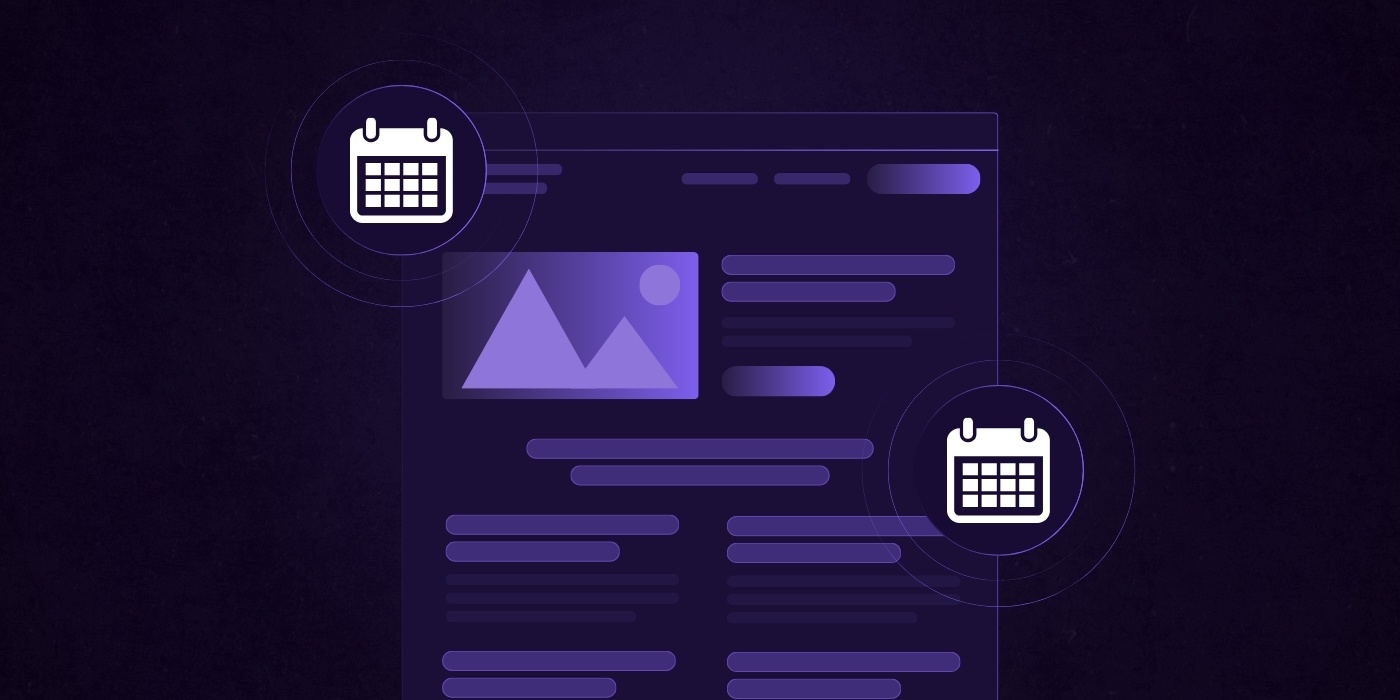-
Strategy
-
Understanding The Average Website Lifespan & When To Redesign
Websites are typically a considerable investment of time and money for most organizations. To make sure you’re making the most of both, you want to at least be average, right?
Well then, that raises a few questions:
- What is the average lifespan of a website?
- How often should someone redesign their website?
- When does it make sense to redesign the website?
In the past, recommendations about how often to redesign a website are frequently based on anecdotal evidence rather than hard data. Before deciding to move forward, it's essential to evaluate your current website's performance metrics, such as load times, bounce rates, and conversion rates, to determine if a redesign is necessary.
We took it upon ourselves to provide real data based off real websites, not just “what we feel is best”.
So if you’re interested in real data, let’s dive in.
PS: A website is typically redesigned to improve its design, functionality, or user experience. For the purpose of this article, when we say ‘average website lifespan,’ we’re effectively referring to the average time a website remains mostly unchanged before undergoing a complete website redesign. The timing stamps referenced are the span of time since the last redesign.
What Is the Overall Average Website Lifespan?
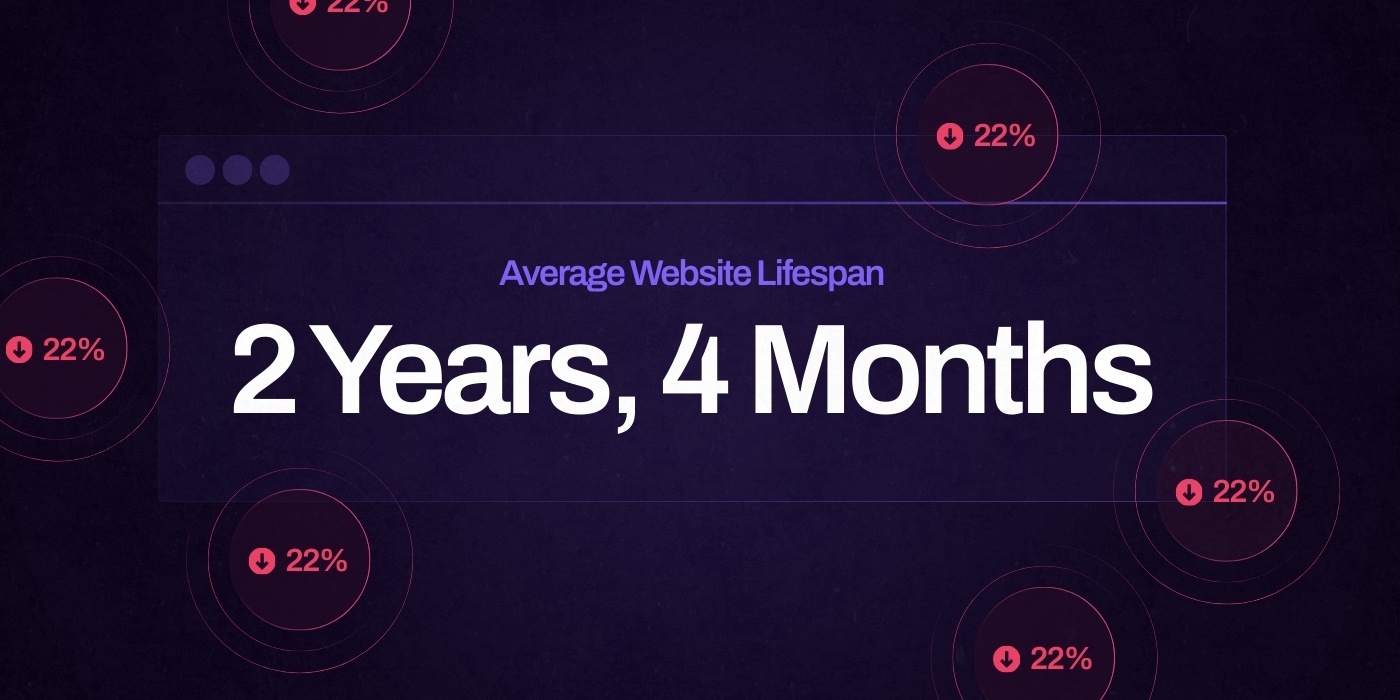
For our dataset, we choose to review the top 500 websites from this year’s INC 5000, along with several dozen of our client websites with the Wayback Machine.
We examined the design and layout of each site over a specific period and calculated the time between significant website redesigns.
What did we discover?
The overall average lifespan of a website has been shortened to 2 years and 4 months (22% less than what’s conventionally promoted).
What Is the Lifespan of Websites Per Industry?
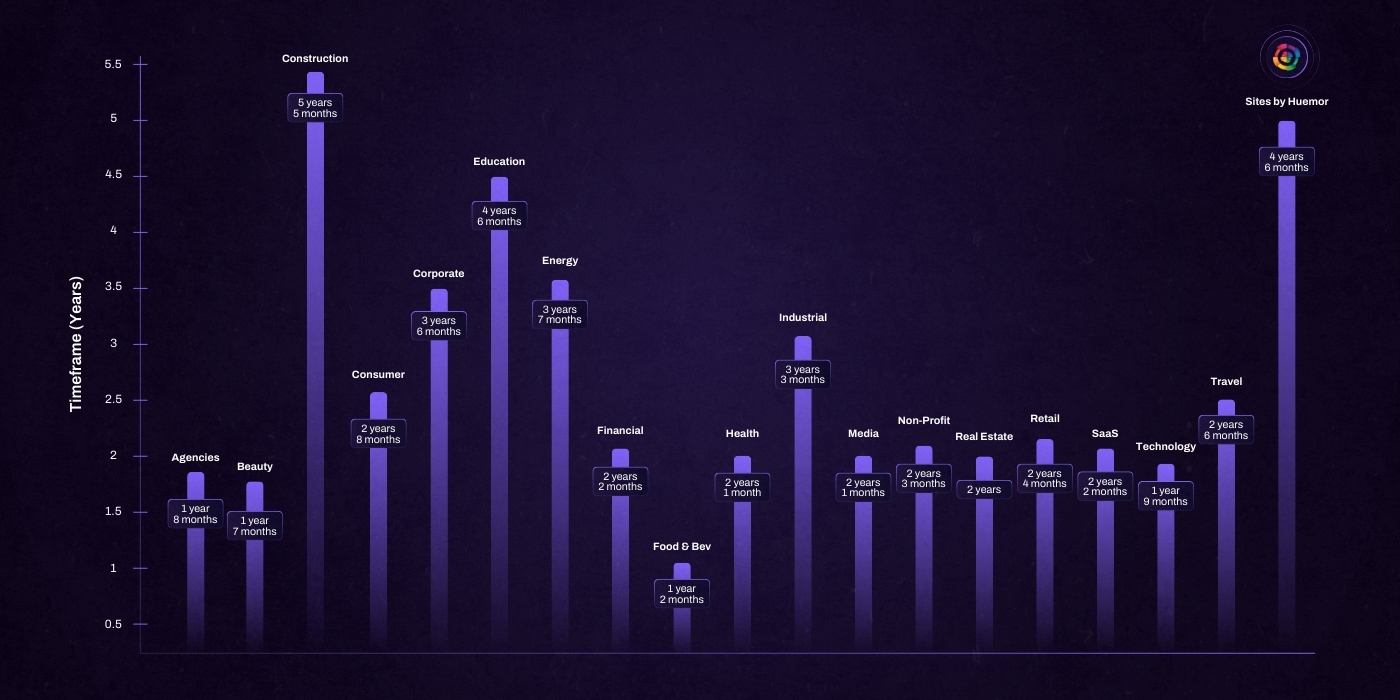
As mentioned, our research involved observing the top 500 websites on the INC 5000 list and a few dozen of our own clients to determine the life expectancy of websites by industry. Here’s what we found:
- Agencies: 1 year, 8 months
- Beauty: 1 year, 7 months
- Construction: 5 years, 5 months
- Consumer products & services: 2 years, 8 months
- Corporate: 3 years, 6 months
- Education: 4 years, 6 months
- Energy: 3 years, 7 months
- Financial: 2 years, 2 months
- Food & beverage: 1 year, 2 months
- Health: 2 years, 1 month
- Industrial & manufacturing: 3 years, 3 months
- Media & publishing: 2 years, 1 month
- Non-profit: 2 years, 3 months
- Real estate: 2 years
- Retail: 2 years, 4 months
- SaaS: 2 years, 2 months
- Technology/IT: 1 year, 9 months
- Travel & Hospitality: 2 years, 6 months
- Sites by Huemor: 4 years, 6 months
In some industries, websites may have shorter lifespans because they are poorly maintained, which can lead to more frequent redesigns.
But overall, this data indicates that beauty brands, on average, appear to redesign their website most frequently, while construction companies redesign their websites least frequently.
We were also blown away to discover that websites built by us on average outperform the average lifespan by more than 60%.
What Causes Frequent Website Redesigns?
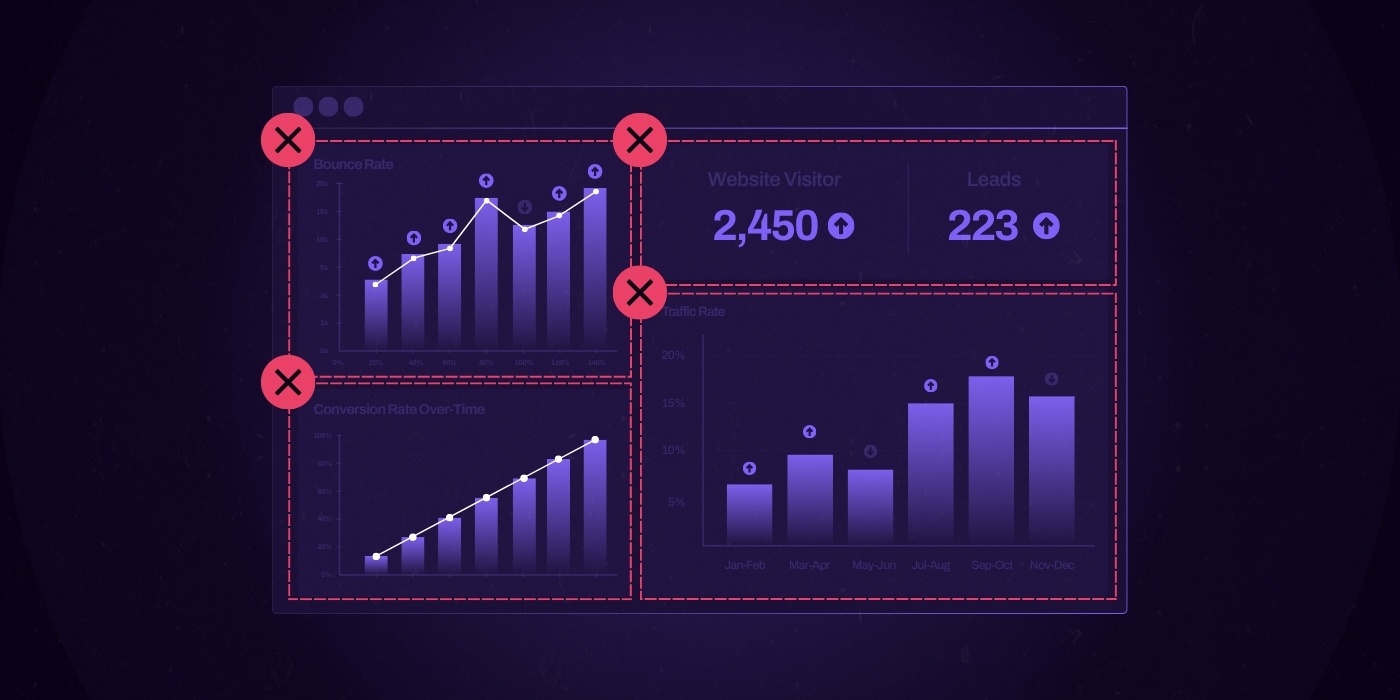
It’s not uncommon for us to work with a client that had their website “professionally done” the year before.
Despite the investment, they still weren’t satisfied with the outcome. Why? Poor planning.
Redesigns fail when there’s no real plan behind them. Rushed timelines, failure to define clear redesign goals before starting the project, and lack of alignment can leave you with a site that feels outdated the moment it launches and doesn’t move the needle at all. It’s crucial to plan the entire process of a website redesign from start to finish to ensure long-term success.
Whether you’re a startup or an enterprise, your next website redesign project plan needs to be rooted in strategy. Know what’s broken, what’s working, and where you want to go.
Part of this is your responsibility as the client, but ultimately the majority of the responsibility rests on the website redesign agency you choose to partner with.
Pro Tip: It's important to allow ample time between redesigns so your website can gather meaningful data, establish authority, and maintain overall site quality. How often should you redesign your website depends on factors like performance, technological advancements, and design relevance, rather than a fixed schedule.
How To Extend the Lifespan of Your Website

You don’t need a full redesign every year to keep your website feeling fresh. Small, strategic updates to its look and feel can add months (or even years) to its shelf life. Some things to focus on:
- Swap outdated visuals
- Update visual elements and design elements to ensure your site remains engaging and modern
- Refresh key sections and review the visual aspects of your website, such as color palette and imagery
- Reevaluate your design every so often to make sure it still aligns with your brand and where the industry is heading
- Consider a web design refresh to keep up with current trends
Let's go a little deeper.
Keep Your Website Fresh (or Risk Losing Trust)
Your website isn’t a one-and-done project. As your business grows and the market shifts, your site needs to evolve with it. When information is outdated or irrelevant, it doesn’t just confuse your visitors, it erodes trust.
That page about a product you no longer offer? A team member who left years ago? It’s sending the wrong message.
Keeping your content current not only creates a better experience for your users—it also shows Google your site is active, helping you rank higher and reach more of the right people.
Bottom line: If your website doesn’t reflect where your company is today, it’s already falling behind.
Pro Tip: Every three months evaluate your messaging. Does it still align with what your best customers care about? If the answer is ‘no’ it needs to change. Through content management consumers will be able to find the content that matters to them as well as help to answer any questions they have about your company.
Re-work the Homepage
If you’re going to refresh your site, start where it matters most, your homepage. It’s your digital first impression, and in a few seconds, visitors should know exactly what you do and why they should care. Include clear call-to-action buttons or interactive elements to draw users further into your site and boost engagement.
Clean up any clutter. Swap in updated imagery. Refresh colors and visual elements to match where your brand is today. These updates can instantly make your site feel more modern and aligned with your audience.
Just keep in mind: a homepage refresh is a great first step but without updating the rest of your site, you risk creating a disconnect. Consistency matters.
Tighten Up Your Copy
Your website copy should evolve as your business does. Start by cutting the fluff. Remove outdated or unnecessary info, and make sure what’s left clearly reflects where your company is today.
Product and service descriptions, especially product descriptions, should be accurate, compelling, and tailored to what your customers are looking for right now. Well-written product descriptions can significantly influence user decisions and drive conversions. Organizing content effectively across individual pages also improves website clarity and enhances the user experience. If someone finds your site through search, your copy needs to quickly convince them that you have the solution they need.
Regularly reviewing and refining your content not only builds trust with your audience—it also tells Google your site is active, boosting your visibility where it counts.
Invest in Fresh Assets
Sometimes, all your website needs is a visual pick-me-up. New photography or video can breathe fresh life into your existing pages, no lengthy redesign required.
Whether it's updated product shots, team photos, or a polished brand video, refreshed content makes your site feel current and credible. Bonus: these assets aren’t just for now, they’ll pull double duty when it’s time for a full revamp down the line.
Smart move, minimal lift, high impact.
Optimize for Conversion
If your site looks solid but leads and sales are underperforming, it might be time to double down on conversion optimization. Low conversion rates and poor user experience can signal underlying issues that need to be addressed to improve performance.
This isn’t guesswork. It’s strategic testing across high-impact areas: your homepage, landing pages, blog, pricing page, to uncover what’s blocking visitors from taking action. Monitoring bounce rate is also essential, as a high bounce rate can indicate problems with user engagement or content relevance.
When done right, conversion optimization helps you attract better-fit leads, increase revenue, lower acquisition costs, and get more from the traffic you already have.
More qualified leads. More wins. No redesign required.
Streamline Your Navigation
Your navigation isn’t just a menu, it’s the roadmap to your entire website. Making it easy for users to navigate your website is crucial for engagement and conversions. Adding key pages or removing deadweight can make a massive difference in how users explore and engage, and optimizing your site's navigation for better usability ensures important content is always accessible.
Start by cutting links that rarely get clicked. Remove broken links to improve user experience and site quality. Keep things focused, intuitive, and aligned with how your visitors actually think. A clean, purposeful nav helps users find what they need faster, keeping them on your site longer and moving them closer to converting.
Better experience, better results. Simple as that.
What Factors Typically Spark the Need for a Website Redesign?
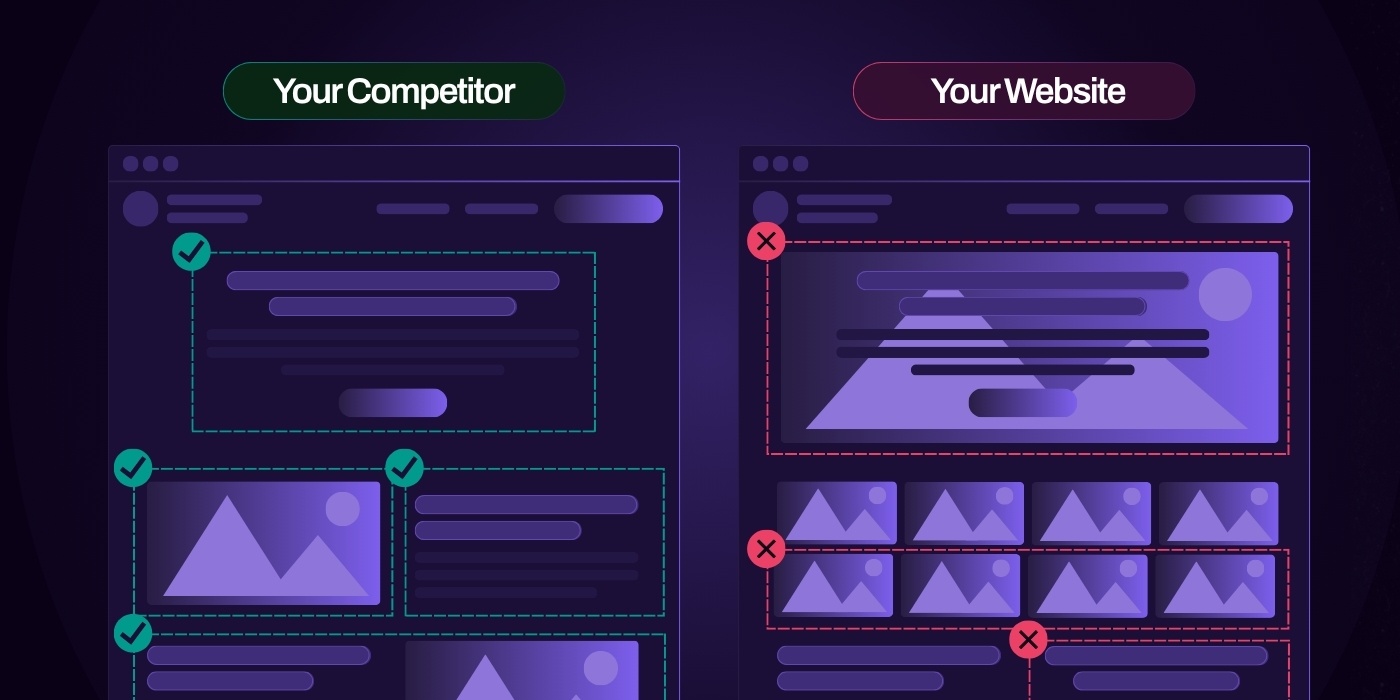
So despite the effort to extend the lifespan of your website, all things inevitably come to an end.
Sometimes, a complete website overhaul may be necessary when your current site no longer meets your business needs or keeps up with industry standards.
Let’s take a moment to focus on the signs your website’s reached the end of its useful life. Here are some surefire indications that it's time to redesign your website:
Your Competitors are Gaining The Edge
Your competitors aren’t standing still. They’re updating their messaging, improving UX, and investing in design that speaks to your shared audience.
If your site hasn’t evolved lately, it’s probably starting to show.
Take a look around. What are your competitors doing better? Where do they fall short?
Analyze competitors' websites to identify their strengths and weaknesses. This can reveal opportunities for your own improvements. Use those insights to guide your next move because prospective customers will compare your website to theirs.
To stay ahead, your site needs to feel modern, rank well, and clearly show why you’re the better choice.
Food For Thought: Your website is often the first point of contact for potential customers, making first impressions critical. Outdated design and cluttered design are common reasons for a site redesign, as they can negatively impact user experience and brand perception. Maintaining a strong web presence is essential to effectively reach and serve your audience.
When Growth Outpaces Your Website
As your business grows, your website needs to keep up. You can only bolt on so many pages or features before things start to feel disjointed.
Expanded service offerings? A shift from B2B to B2C? These aren’t minor tweaks—they’re game changers that call for a strategic overhaul.
That means rethinking not just your content and structure, but how your site supports your broader marketing and sales goals. For example, targeting new business opportunities through your website can help attract a wider range of buyer personas and drive increased sales.
When planning a redesign, identify the pages that receive the most traffic and prioritize them to maximize user engagement and SEO benefits.
Your website is your brand’s front door. If it doesn’t clearly communicate who you help and why you’re the best choice, your visitors won’t stick around long enough to find out.
Food For Thought: If your site no longer reflects who you are or where you’re headed, it’s probably time for a fresh start. When considering business goals, it’s important to align your marketing efforts and target the right audience to maximize impact and relevance. Updating your branding and the website's design ensures your online presence matches your current identity and business direction.
The Tech is Holding You Back
Small upgrades, like swapping in a sharper logo, can help keep your site feeling fresh. But when it comes to major tech shifts (like mobile-first design, CMS flexibility, or third-party integrations), patchwork fixes just won’t cut it.
If your site still struggles on mobile, takes forever to load, or makes backend updates a nightmare for your team, it’s time for something better.
Modern businesses need websites that move fast, scale easily, and play nicely with the tools they rely on. A strategic redesign built on the right platform clears out those limitations—and gives both your team and your users the experience they expect.
It’s Not A Good Visual Representation of the Current Company
If your business has gone through a major evolution: new positioning, new messaging, new visual identity, but your website still looks like the old you, it’s not just out of sync. It’s actively holding you back.
Your site should reflect who you are today, not who you were three years ago. If the design feels off-brand, if the voice no longer matches your personality, or if the visuals scream “we haven’t updated this since the rebrand,” you’re creating confusion instead of confidence.
A shift in brand identity isn’t just a reason to update your site, it’s a reason to rethink it entirely.
Launching a thoroughly tested and well-planned redesigned site is essential to ensure your new brand is accurately represented and functions smoothly for users.
Because when your website doesn’t support the brand you’ve become, it undermines everything you’ve worked to build.
The Website Isn’t Creating Business Opportunities
Let’s call it like it is: if your website isn’t consistently generating qualified leads, it’s failing at its most important job.
Your site should be more than a digital brochure. It should attract the right people, guide them through your value prop, and convert them into real opportunities. If that’s not happening, you’re leaving revenue on the table (and likely handing it to your competitors).
Whether it’s weak messaging, poor UX, or a lack of strategic calls to action, something’s blocking your visitors from taking the next step. And that’s a problem worth fixing.
The Website Isn’t Creating Business Opportunities
Search visibility isn’t optional, it’s foundational. If your website isn’t ranking for the terms your ideal customers are searching, you’re invisible to the people who matter most.
It doesn’t matter how strong your messaging is or how compelling your offer sounds if no one can find you, none of it gets seen.
SEO is still one of the biggest drivers of qualified traffic and long-term growth. It’s how people discover your brand, evaluate your relevance, and decide whether you’re worth their time. Using Google Analytics to monitor website performance, track user behavior, and identify areas for improvement is essential for maintaining and increasing your search visibility.
If your website isn’t built to compete in search, you’re not just missing opportunities, you’re handing them to someone else.
Pro Tip: During a redesign, it's also crucial to manage old urls by mapping and redirecting them to preserve SEO rankings and ensure a smooth user experience.
How To Finally Decide It’s Time for A Website Redesign

Clinging to a website that no longer works is costing you more than just credibility. It’s likely costing you leads, revenue, and momentum.
Start by assessing your current site to evaluate its content, structure, and SEO performance. This will help determine if a redesign is necessary.
Here’s how to make the call with confidence based on real insights, not guesswork.
1. Start With the People Who Matter Most: Your Customers
Your customers are already telling you what’s working and what’s not. You just have to listen.
- User Interviews: Talk to recent customers or even lost deals. Ask how they found your site, what they expected, and what fell short.
- On-Site Behavior: Tools like heatmaps and scroll tracking don’t lie. If users aren’t making it past the fold or ignoring CTAs, something’s broken in the journey.
- Surveys & Feedback: Whether it’s an NPS follow-up or a quick feedback widget, ask real users how they felt about their experience on your site. Actively gathering and analyzing user feedback helps identify issues and informs website improvements based on what users report.
What you’re looking for: Confusion. Drop-off points. Struggles to find key information. These are all signs that your site isn’t pulling its weight—and no amount of PPC or clever messaging can fix that alone.
2. Check In With Your Internal Stakeholders
If your internal teams are out of sync with your site, your customers will feel it.
- Marketing & Sales: Are they getting the right leads? Are prospects coming in already confused or under-informed?
- Product or Service Teams: Have your offerings expanded or shifted direction in a way that’s not reflected on the site?
- Leadership: Has your brand identity evolved? Are your goals now focused on a different audience, industry, or positioning?
What you’re looking for: Any gap between what teams need the site to do—and what it’s actually doing. If your website no longer supports the business strategy, it’s not a marketing asset. It’s a liability.
3. Audit the Performance Metrics
Your gut might have opinions. Your metrics have facts.
- Is lead volume dropping off?
- Is your organic traffic stagnating while competitors climb?
- Are conversion rates on key pages like “Contact” or “Pricing” below industry benchmarks?
- Are users bouncing because of slow load times or poor mobile experience?
What you’re looking for: Trends that don’t align with the effort you’re putting in elsewhere. If your campaigns are solid but the website underperforms, it’s not the traffic—it’s the site.
Websites Don’t Last Forever—And That’s Okay
As our research shows, the average website lifespan is just 2 years and 4 months. In faster-moving industries, it’s even shorter.
That might feel surprisingly quick—but it makes sense.
Your business evolves. Your customers expect more. Technology changes. And the bar for digital experiences keeps rising.
In some cases, small strategic improvements like we’ve outlined can extend the lifespan of your website by months (or possibly years). This, however, assumes that the website is in a decent state.
Trying to squeeze another year out of a site that’s already really underperforming won’t save you money but it will cost you leads, credibility, and long-term growth.
Redesigning your website shouldn’t be reactive or emotional.
It should be a strategic decision, backed by customer insights, internal alignment, and performance data.
When all three are signaling the same thing, you can stop wondering if it’s time and start building something better.
Because at the end of the day your website has a job: to win trust, drive growth, and move your business forward.
If it’s not doing that, it’s time to rethink the entire experience.
Website Redesign Blueprint
Want the full blueprint for your next redesign?
Our website redesign blueprint gives you all the tools you need to make your next project a success. A digital guide, a full redesign checklist, agency interview cheatsheet, and website redesign RFP template.
